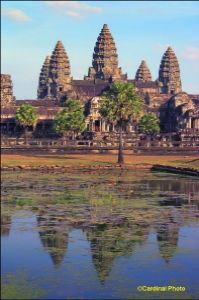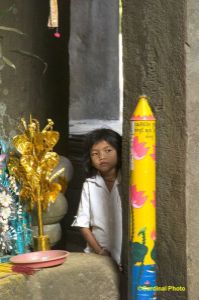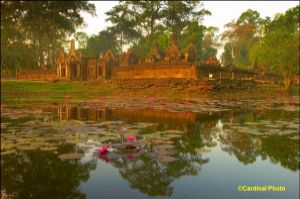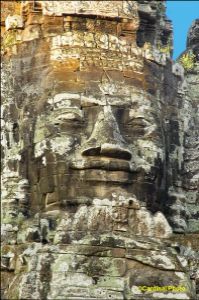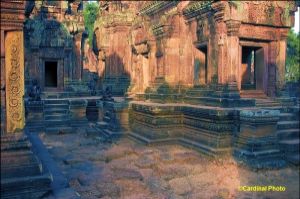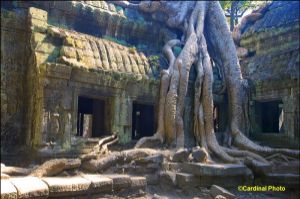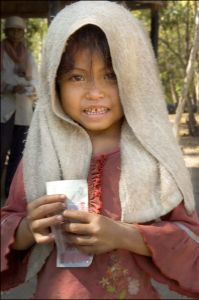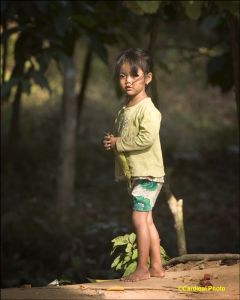DigitalPro Shooter Volume 3, Issue 1, January 26, 2005
Photographing the Magic of Angkor Wat
Welcome to DPS 3-1. We've been publishing DigitalPro Shooter for over 3 years, but wanted to mark the arrival of 2005 by offiically starting our 3rd volume with a special issue on Angkor Wat and the surrounding Cambodian temples. We have also got some great news about two new services of use to most photographers in our New Products section.
Angkor Wat and the surrounding Angkor temple complex in Cambodia are without question one of the seven man made wonders of the world. Even after nearly 1000 years of neglect the dozens of spires and thousands of feet of intricate stone carving--all without the use of mortar or any machines--stand as a monument to what ancient civilizations were capable of. The art in photographing them is in culling out bite-size chunks from the overwhelming experience so that your camera can make sense of them. In this issue I'll take you through my recent trip there and give you some ideas on how to approach photographing Angkor or other similar ancient wonders.
|
Ever since seeing a large model of Angkor Wat in Thailand and photos of it at the Smithsonian, it is been top on my list of "must see" locations. The security situation in Cambodia and the sheer logistics had made it difficult to get there, but it has never been easier to see one of the true wonders of the world so I was determined to make the effort on my most recent trip to Asia. The visit was worth it in every way. The sheer variety of temples is impressive, as is there size and age (many are over a thousand years old and almost all of them were built by hand from massive stones at least 700 years ago), but most impressive to me was the almost uninterrupted and intricate carvings that covered every surface. |
About the Angkor temples
|
There are literally thousands of temples and shrines in and around what is known as the Angkor temple complex. Angkor Wat is only one of them, although it is by far the most famous. It's sheer scale is breathtaking. Imagine a structure the size of the US Pentagon built by hand from sandstone, then surrounded by an even larger wall and moat. Now imagine covering nearly every square inch of the buildings surface with ornate stone carving depicting various stories and myths. All this was done nearly 1000 years ago by a civilization that had apparently not even discovered the arch--as all of the covered areas either relied on lintels or stacks of rocks which met in the center. |
But many of the other temples are almost as spectacular and often more interesting to tour since Angkor Wat is the most crowded. The beautiful Bantay Srei, for example, has gorgeously colored stone and some of the prettiest carvings of the complex. Angkor Thom is literally a city in itself, with several one of a kind gates. And Pra <> is famous for the trees that have overgrown the temple. The temples have been restored in a variety of ways. Some have been nearly rebuilt to the way they might have looked originally, while others have been reconstructed from original materials as available but not rebuilt further. And finally, some have been left with the trees growing through them or the way they were found. This variety lets you experience Angkor as it might have been through the ages. |
|
Frankly there is no way I can do the temples justice in this newsletter, but fortunately there is finally an awesome and not too expensive book on them which can serve as a great source of information and inspiration, and is convenient enough to double as a travel guide. Ancient Angkor is a must have for anyone interested in the Angkor temples. Unlike most guidebooks the photos are stunning and unlike most photo books there is plenty of detail on how to get around and what to look for. When to photograph the temples...Shhh.... Please don't let the word get around but the biggest secret to photographing both Angkor Wat and the other temples is to get up early. At sunrise the temples are nearly deserted, the light is perfect and the surroundings are quiet except for the birds. Even the normally omnipresent postcard-sellers haven't arrived yet. Most of the tour groups leave their hotels between 7 and 8 and arrive between 8 and 9, leaving you--depending on the time of year--with 2 to 3 hours of great shooting in the early morning light before things get hot and crowded. Speaking of time of year, the most popular season to visit is the dry winter months. Don't be confused by the term winter, as daytimes highs can still be over 100 and evenings only get to the 60s or 70s. The dry conditions mean that you can get a full day of photography every day. Unfortunately they also mean you are less likely to get dramatic cloud formations and the foliage will not be as lush. Don't expect to get those lush shots of green rice paddies if you come too long after the rains have ended. |
Light and Darkness: Handling Contrast
Like many famous attractions, you are limited both in the times you can photograph the temples and in the viewpoints you can use. Likewise, you will probably only be there for a few days, and only make the trip once. So your ability to get the weather or light you want will be limited. The upshot is that you'll need to deal with extremes of light and dark, often in the same frame. With digital the most flexible tool for doing this is multiple raw images--requiring a tripod of course--and compositing in Photoshop which we described how to do in DPS 2-21. In many cases the problem is the sky being much brighter than the often shady temple. If you're not interested in creating a multi-shot composite you can either compose to avoid the sky, shoot very early or very late when there is less contrast, or use a split neutral density filter. I found myself often using up to 5 stops of split ND filters (stacking my 2-stop & 3-stop filters) for some scenes. |
Viewpoints & Crowds
|
Unlike similar sites in the US, for example, you are allowed to crawl all over most of the temples. That's good for getting unique viewpoints, but also means that there are people all over the site who you may not want in your photograph. Starting early is the best way to have uncluttered frames, but that isn't always possible. Other strategies include patiently waiting with your tripod set up and remote release in hand for the moment when that tourist in white hat and red shirt is blissfully out of sight behind a pillar or taking several frames of the same scene and layering them together to "paint" out the people. Or of course you can often clone or "heal" them out by brute force in Photoshop. TIP: Tourists wearing earth tones will fade into the background on wide angle shots. It is the ones in bright colors, particularly red and white, that will really become an eyesore in your image. |
Don't forget the People
|
One of the aspects of travel I enjoy the most is people. The temple area is surrounded with interesting people doing interesting things. Whether it is the women carrying firewood on the back of their bicycles, the men carrying picks to market on the backs of their motorcycles or children scampering up and down the ruins there are plenty of activities to see and photograph. Monks in their orange robes also make a colorful subject although I'm always sure to ask if it is okay to photograph them first and try to donate to them if appropriate. The only disappointing aspect of photographing children near the temple area is that they have become accustomed to begging and in particular to "charging" foreigners to take their picture. If you are able to travel out to the countryside to some of the smaller villages things are a little more settled down and strangers are more of a novelty. |
TSUNAMI: Obviously this holiday season has been unique in Southeast Asia because of the 9.0 earthquake and resulting tsunami. I was in Bangkok when the quake hit, on the 12th floor of an apartment building, and we felt the building shake aggressively for 30 seconds or so. But there was no damage in the city or nearby. Fortunately all of the people we knew personally on Phuket were safe, although our hosts lost several friends and acquaintances. This was of course nothing compared to the extensive tragedies suffered by several hundred thousand people and their families throughout the region. The aftermath has been painful for many, but Thailand in particular seems to be moving quickly back to normal. If you'd like to donate to the relief cause, we can recommend either the American Red Cross or Oxfam, but of course there are many other worthy organizations doing incredible work. Even without having been touched by the tsunami, life in Cambodia can be harsh. The third leading cause of death is land mines, and one of the temples we visited has only been open for a few months because the mines have just recently been cleared away. Only 30 years ago Cambodians lived through Pol Pot and the infamous Killing Fields followed by a harsh Vietnamese "occupation" government until 1990. |
Return Visit
More than any other site I've visited in Asia, Angkor is ideal for a photo trip. I would very much like to return, and perhaps lead a photo trip there. My schedule is full for 2005, but perhaps in 2006 or 2007. If it is the type of trip you'd be interested in, please send me an email at safaris@cardinalphoto.com and I'll make sure and let you know when something works out. Equipment Note: Nikon had wanted to provide me with a D2X for this trip, but they were not available yet. I would have loved the extra resolution for making large prints, but by using JPEG+Raw mode on my pair of D2H's I've been able to capture detailed images that have been suitable for fairly large prints when I take care to scale & sharpen them carefully. I certainly look forward to returning with a D2X though! |
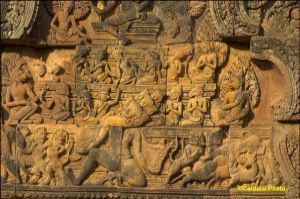 |
New Products: Mentoring & Used Equipment Sales
Sometimes lost in the rush to write about all the new products and tools are those critical services that help make us effective as photographers. First and foremost are those which help us improve our skills. Moose Peterson, undoubtedly one of the world's foremost wildlife photographers and photography authors is now offering a customized Mentor program to 4 students per year. Each mentorship lasts for three months and includes an intensive set of assignments, admission to a DLWS, a weekend shooting with Moose and other goodies designed to help you bootstrap your photography. Moose also offers 1:1 private tutoring in photography. From having worked with Moose for many years I can personally attest to how much you can learn from being around him. For more details visit his WRP site.
On a more day to day level Laurie Excel has started a new business that is guaranteed to improve your bottom line. As The Equipment Lady Laurie will sell your used photo gear for you. She has done this for years both for herself and for others and has tremendous experience in setting prices and determining the best way to sell an item. Using The Equipment Lady is guaranteed to save you time and it might not cost you as much as you think since she may get a better price than you would have. Laurie has been buying and selling gear for me for several years and I've always been pleased with the results.
DigitalPro Tip
You can edit your IPTC Categories and Keywords right from the main window. Just make sure to have the Collections & Keywords windows visible (via the Window menu), then use Collections under IPTC Categories and the Keywords of your choice. As long as you also have the option to sync with IPTC data set your changes will automatically be refected in your IPTC-compliant image files.
Search our Sites:
